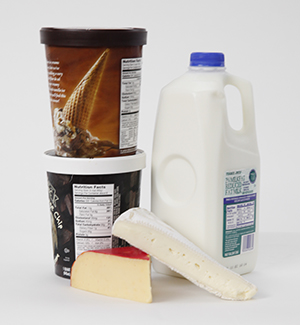When Your Child Has a Food Allergy: Milk
When a child has a milk allergy, even a small amount of milk can cause a serious reaction. For that reason, your child must stay away from dairy products and any foods likely to contain milk. Make sure you know:
-
About milk allergy
-
What foods to stay away from
-
What to look for on food labels
-
How to prepare dairy-free meals
-
Choices for feeding a baby with a milk allergy
Foods to stay away from
Children with milk allergies should not eat any dairy foods, including:
-
Butter. Also some margarines, butter substitutes, and spreads. Some "nondairy" spreads, including margarine, contain whey, a milk protein.
-
Cheese. Cheese made from rice or soy may also contain casein, a milk protein.
-
Cream, sour cream, half-and-half, and some "nondairy" creamers
-
Ice cream, frozen yogurt, and sherbet
-
Milk. This includes whole, low-fat, skim, evaporated, condensed, powdered, buttermilk, and goat's milk.
-
Yogurt

Some children with milk allergy are able to eat baked goods with milk. Talk with your child's healthcare provider to find out if baked milk is safe for your child. The following foods often contain milk.
Desserts
-
Baked goods, such as cakes, muffins, and some cookies and pies
-
Puddings, custards, and cream sauces
-
Eggnog, milkshakes, and malts
-
Candy made with milk, such as fudge, caramel, and nougat
Meats, other meat dishes
-
Meatloaf, breaded meats, and deli meats containing casein, a milk protein
-
Many processed meats, including hot dogs, sausages, and luncheon meats
-
Canned tuna containing casein
-
Cream soups, bisques, and chowders
-
Pizza
Starches
-
Pancakes, waffles, and french toast
-
Some boxed cereals or precooked cereals
-
Some breads
Vegetables
-
Frozen vegetables in sauce
-
Buttered, creamed, scalloped, or au gratin vegetables
-
Mashed, au gratin, creamed, and scalloped potatoes. Some french fries may contain lactose, a milk sugar.
Other foods
-
Salad dressings or mayonnaise containing milk, milk solids, or milk products
-
Caesar salad and Caesar dressing. These often have Parmesan cheese.
-
Some high-protein flours and protein powders
Medicines
What to look for on labels
Food labels can be misleading. “Nondairy” foods often contain milk proteins, such as casein and whey. These will be on the ingredients list. And kosher foods labeled “pareve” may have traces of milk from processing. Pareve means the food doesn't contain meat or dairy products. Foods that contain milk are required to have the word "milk" on the ingredients label. Sometimes the label will have an allergy statement such as "contains milk." Read labels carefully, and stay away from products that contain:
Some foods and products don't have to state if they contain milk. These include:
-
Foods not regulated by the FDA
-
Cosmetics and personal care items
-
Prescription and over-the-counter medicines and supplements
-
Toys and crafts
-
Pet food
Allowed foods
These foods are usually safe for children with milk allergies:
-
Boxed pastas, such as macaroni and spaghetti
-
Breads made without milk
-
Fresh and frozen fruits and vegetables
-
Fresh, frozen, or canned fruit and vegetable juices
-
Grains, such as rice, wheat, barley, and oats
-
Meat, chicken, and fish cooked without butter or other milk products. Precooked meats, such as ham, may contain lactose.
-
Noncream soups
-
Peanut butter and other nut butters made without milk solids
-
Rice, soy, and nut milks.
-
Sauces that don’t contain milk or cream, such as spaghetti sauce
-
Tofu and other soy products
-
Vegetable oils
-
White or sweet potatoes cooked and served without butter or milk
Cooking without milk
Try these tips for making your favorite recipes without dairy products:
-
In baking, substitute equal amounts of water, fruit juice, rice milk, or soy milk for cow’s milk.
-
Use three-quarter cup applesauce for every cup of butter called for in baked goods, or use a butter substitute made from soy.
-
Use chicken broth for cream in sauces and soups, or puree foods for a creamy texture.
-
Dress potatoes, vegetables, and grains with olive oil, vegetable oil, or soy lecithin spread instead of butter.
Your child needs calcium
Ask your healthcare provider about calcium or vitamin D supplements for your child. Be aware some will contain milk, so be sure to read the labels. These foods are good sources of calcium:
-
Calcium-fortified orange juice
-
Canned salmon (with bones) and sardines
-
Cooked dried beans
-
Enriched soy milk and rice milk
-
Soy yogurt
-
Tofu
-
Turnip greens, kale, broccoli, and cabbage
If your baby has a milk allergy
Your child's healthcare provider can help you make a plan for feeding your baby. It may include:
-
Breastfeeding. Breastmilk provides very good nutrition for babies. The healthcare provider may advise that you stop eating the food your child is allergic to. This is because some food proteins can pass through breastmilk and cause symptoms in your baby.
-
Formula. Your child's healthcare provider can help you know what formula to feed your baby. This may be an extensively hydrolyzed formula or an amino acid-based formula. These special formulas are better digested by babies with a milk allergy. Other types of formula may contain milk. These aren't recommended for babies with a milk allergy. Don't make your own formula. If you need help affording formula, ask your child's healthcare team about resources. These include the Special Supplemental Nutrition Program for Women, Infants, and Children (WIC) or Supplemental Nutrition Assistance Program (SNAP). Health insurance may pay for special formula that is medically necessary.
If your child has any of the symptoms listed below, act quickly!
If an epinephrine auto-injector has been prescribed, use it right away. Then call 911.
-
Trouble breathing or a cough that won’t stop
-
Swelling of the mouth or face
-
Dizziness or fainting
-
Vomiting or severe diarrhea